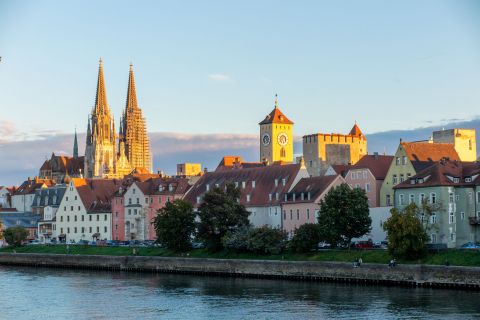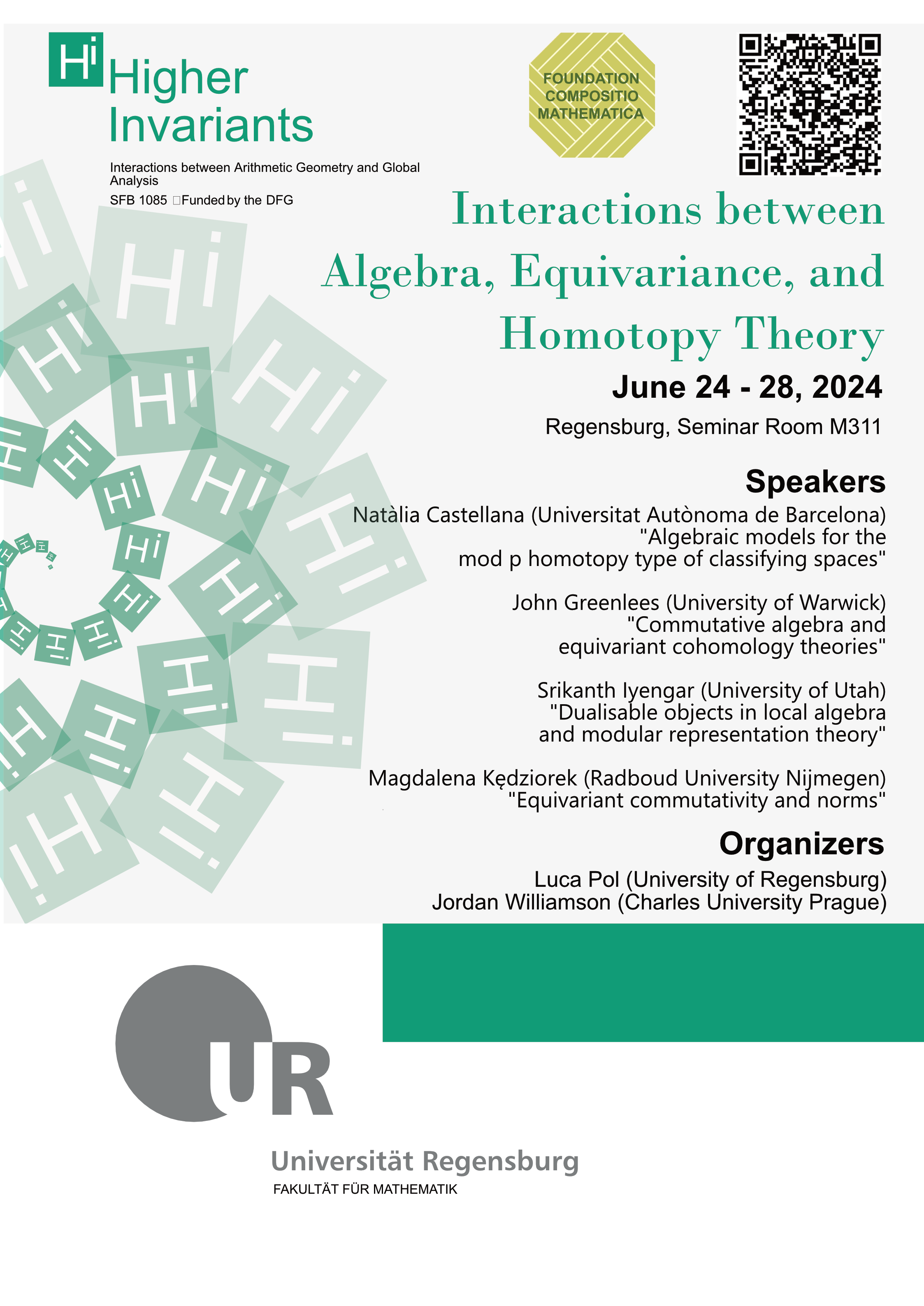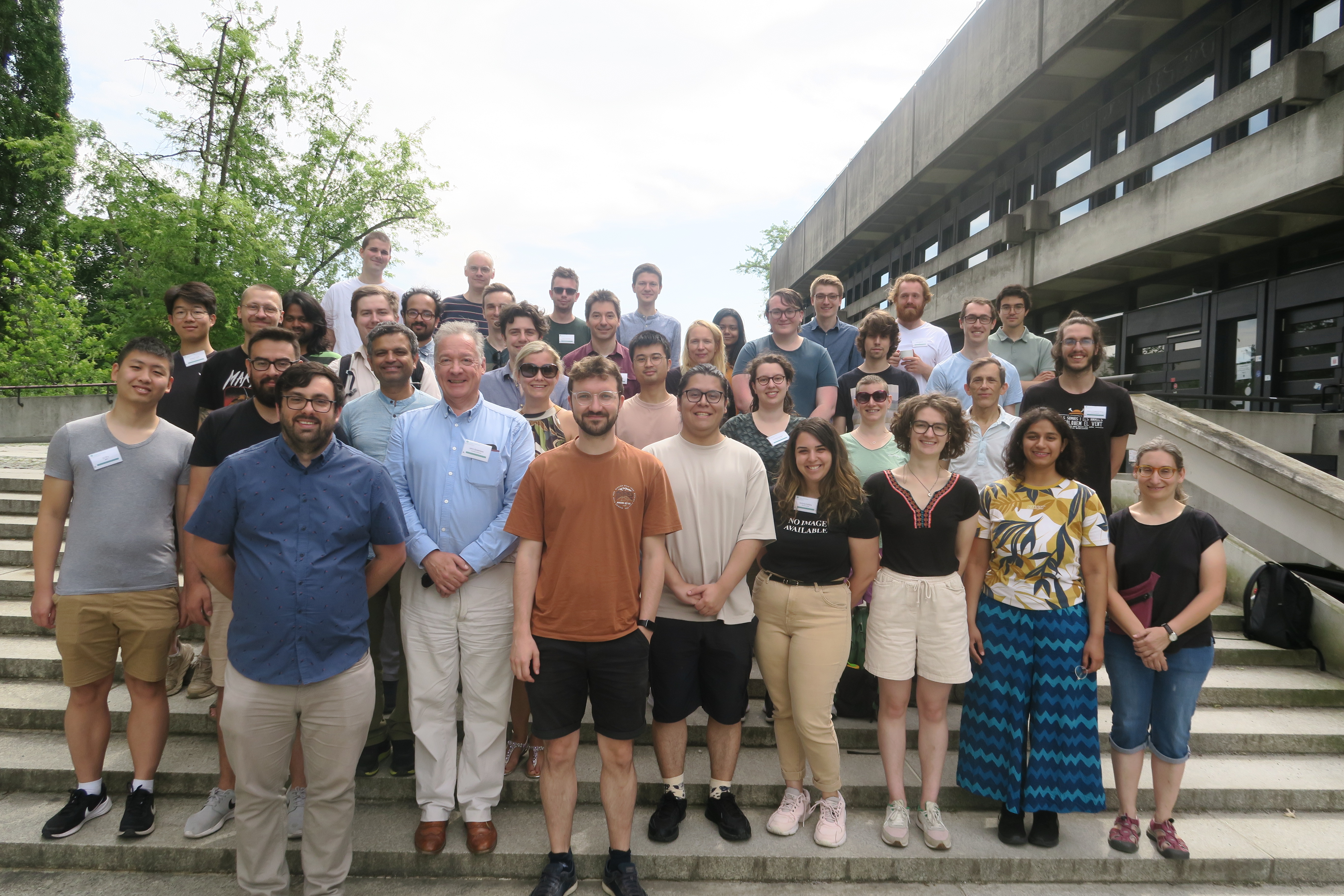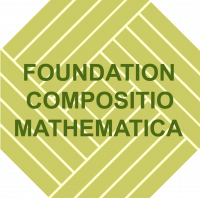

HomeAboutPeopleEventsResearchRTGGuest ProgrammeImpressum
Summer School Interactions between Algebra, Equivariance, and Homotopy Theory (June 24-28, 2024)
Aim and Scope
The aim of the summer school is to bring
together researchers in algebra and homotopy theory, especially those with a link to equivariant
methods, and seek to encourage collaboration and interaction between these different, yet
deeply related fields. A key focus of this summer school is on early career researchers.
Invited Speakers
- John Greenlees "Commutative algebra and equivariant cohomology theories",
- Natalia Castellana "Algebraic models for the mod p homotopy type of classifying spaces",
- Magdalena Kędziorek "Equivariant commutativity and norms",
- Srikanth Iyengar "Dualisable objects in local algebra and modular representation theory".
There will also be a series of contributed talks by participants.
Practical Information
City of Regensburg: Regensburg is a Unesco World Heritage site that is famous for its well-preserved medieval city center and its beautiful Gothic cathedral.
Further information about Regensburg can be found here.
Internet: Access to eduroam and BayernWLAN is available throughout the Mathematics Building.
Accomodation: Regensburg is a tourist destination and we encourage guests to book their rooms as early as possible. Here is a list of hotels in the area:
- Hotel Münchner Hof (In the city center, one must take a bus to the University.)
- Hotel Kaiserhof am Dom (In the city center, one must take a bus to the University.)
- Hotel Jakob (In the city center, one must take a bus to the University.)
- Hotel Apollo (Near the University, but limited eating options nearby.)
- Hotel Wiendl (Between the city center and the University.)
- Hotel Central (Between the city center and the University, one must take a bus to the University.)
Family Friendly Campus: Our UR family service offers various rooms for families and services. If you need further information look here.
Venue
All lectures and research talks are in the lecture hall M311, at the 3rd floor of the Mathematics building of Regensburg University (Attention: not the department "Mathematik und Informatik" of the OTH).
One can reach the University of Regensburg by following the instructions here and see here for maps of the campus. Many of the participants will probably arrive by bus at the Central Bus Station of the university which is close to the math building, a bit more towards North (=top of the plan).
Inside of the Mathematics building, use the staircase next to the main entrance and go up to the top.
Schedule
| Time | Monday | Tuesday | Wednesday | Thursday | Friday |
|---|---|---|---|---|---|
| 9:00-9:30 | Registration | ||||
| 9:30-10:30 | Srikanth Iyengar 1 | John Greenlees 2 | Natalia Castellana 2 | Magdalena Kedziorek 3 | Natalia Castellana 3 |
| 10:30-11:00 | Coffee Break | ||||
| 11:00-11:30 | John Greenlees 1 | Magdalena Kedziorek 2 | Srikanth lyengar 2 | John Greenlees 3 | Ahina Nandy |
| 11:30-12:00 | Jorge Eduardo Gaspar Lara | ||||
| 12:00-12:30 | Kamil Rychlewicz | Break | Gabriel Martinez de Cestafe Pumares | Maria Simkova | Gregoire Marc |
| 12:30-13:30 | Lunch | SFB Lecture | Lunch | ||
| 13:30-14:00 | Lunch | ||||
| 14:00-14:30 | Magdalena Kedziorek 1 | Excursion | Srikanth lyengar 3 | ||
| 14:30-15:00 | Natalia Castellana 1 | ||||
| 15:00-15:30 | Maxime Wybouw | Break | |||
| 15:30-16:00 | Break | Marco Praderio Bova | |||
| 16:00-16:30 | Gong Show | Torgeir Aambø | Kabeer Manali Rahul | ||
| 16:30-17:00 | Marius Verner Bach Nielsen | ||||
Lecture series
Natalia Castellana -- Algebraic models for the mod p homotopy type of classifying spaces
For finite groups, group cohomology is a field which exploits the best of both algebraic topology and homological algebra. Choosing different coefficients will reflect different properties of the classifying space and the internal structure of the group. We will focus on the Bousfield p-completion of the classifying space. In this case, the classical stable elements formula due to Cartan and Eilenberg shows how the mod p cohomology only depends on the p-subgroups and its conjugacy relations. This information can be encoded in a category, the fusion category of the finite group.
How much of the mod p homotopy theory can be determined by the fusion category? Work of Puig and Broto-Levi-Oliver formalize an abstract notion of a fusion system on a p-group, its associated classifying space and studied its homotopy theory. In these lectures, the aim is to describe this algebraic model for the local structure at a prime, and show how results in both unstable and stable homotopy theory of classifying spaces at a prime are determined by it.
References:
- Broto-Levi-Oliver, The homotopy theory of fusion systems, JAMS 16, (2003)
- Castellana, Algebraic models in the homotopy theory of classifying spaces, Handbook of homotopy theory
- Barthel-Castellana-Heard-Valenzuela, Stratification and duality for homotopical groups, Advances in Mathematics 354 (2019)
- Cantarero-Castellana-Morales, Vector bundles over p-local groups and Benson-Carlson duality, Journal of the London Mathematical Society 101 (2020)
John Greenlees -- Commutative algebra from equivariant homotopy.
The aim of the lectures is to show the interaction between equivariant homotopy theory and commutative algebra has been beneficial to both subjects. Underlying it are common structures, starting with localization, torsion and completion. The localization theorem was an early link, but did not need much development on the algebra side. On the other hand the Atiyah-Segal Completion Theorem and Carlsson’s Theorem (the Segal Conjecture) led to several developments in understanding, in understanding derived functors of completion and many generator ideals. The Balmer spectrum categorifies the Zariski spectrum from commutative algebra, and gives a way to globalize these connections. Furthermore, one can build on this globalized answer to give a fully algebraic model in suitable circumstances. The lectures aim to follow this development, from the ideal-wise picture, through the geometry to the models, ideally illustrated by examples from both algebra and topology.
[Since time is limited we will not pursue other possible threads connecting commutative algebra and equivariant homotopy theory (eg duality and Gorenstein rings, singularity categories and perhaps complete intersections.)]
The mapping of topics to lectures is unlikely to be precise, but the sequence is
- Torsion modules, complete modules
- The Balmer spectrum of rational G-spectra
- Adelic models of tensor triangulated categories
References:
- J.P.C. Greenlees and JP May “Derived functors of I-adic completion and local homology” Journal of Algebra 149 (1992) 438–453.
- W.G.Dwyer and J.P.C.Greenlees “Complete modules and torsion modules.” American J. Math. 124 (2002) 199-220
- J.P.C. Greenlees “The Balmer spectrum for rational equivariant cohomology theories” JPAA 223 (2019) 2845-2871 arXiv: 1706.07868
- S.Balchin and J.P.C. Greenlees “Adelic models for tensor triangulated categories” Adv. Math. 375 (2020), 107339, 30pp, arXiv: 1903.02669
- S. Balchin and J.P.C. Greenlees “Separated and complete adelic models for 1-dimensional tensor triangulated categories” JPAA 226 (2022) 107109, 42pp, arXiv: 2106.09156
- J.P.C. Greenlees “Rational torus-equivariant stable homotopy V: the torsion Adams spectral sequence.” JPAA 227 (2023) 107300, 31pp, arXiv:2110.00268
- S.Balchin, T.Barthel and J.P.C.Greenlees “Balmer spectra and Priestley spaces” Submitted for publication, 61pp arXiv 2311.18808
Srikanth Iyengar -- Dualisable objects in local algebra and modular representation theory
The derived category of a commutative noetherian ring is stratified (in a way that will be made precise in the lectures) by its spectrum of prime ideals. There is an analogous stratification of the stable module category of a finite group in terms of the spectrum of the cohomology ring of the group. Understanding these local strata takes us a long way towards understanding the global structure of the categories. This lecture series will be about dualisable objects in the local strata. My goal is to explain why they are of interest, and some of the special properties they possess. The local dualisable objects in a given stratum form an essentially small tensor triangulated category. The culmination of the talks will be a description of their Balmer spectrum.
Lecture 1: Tensor triangulated categories: stratification and dualisability
Lecture 2: Local regularity
Lecture 3: Locally dualisable modular representations
The basic references for these lectures are the articles:
- Local dualisable objects in local algebra (with Benson, Krause, and Pevtsova)
- Locally dualisable modular representations and local regularity (with Benson, Krause, Pevtsova)
- Locally dualizable modules abound (with Carlson)
Magdalena Kedziorek -- Equivariant commutativity and norms
Recently, equivariant homotopy theory has provided instrumental tools for solving computational and conceptual problems in algebraic topology. New developments in the field in the last decades created an incredible amount of activity. As a result, a lot of attention in equivariant homotopy theory has been given to various levels of commutativity in that setting. These levels are modelled by N_\infty-operads of Blumberg and Hill and they can be completely classified in terms of algebraic data of transfer systems. This in turn can be understood for many finite groups using combinatorics. There is also a framework capturing different levels of commutativity in global homotopy theory.
In this series of talks, I will concentrate on presenting this landscape and outlining how it combines with algebraic models for rational G-spectra.
Titles and Abstracts
Kamil Rychlewicz -- Equivariant cohomology theories as rings of functions
The classical Poincaré-Hopf theorem shows how to recover the Euler characteristic of a compact manifold from isolated zeros of the vector field. The work of Carrell-Liebermann and Akyildiz-Carrell extended that result, showing that in case of a smooth projective complex variety, one can recover the whole cohomology ring from the ring of functions of the zero scheme of the vector field. Theorem of Brion-Carrell extends it to equivariant cohomology for an action of a Borel of SL_2. Together with Tamas Hausel, we recently generalized the result to any reductive group, or its Borel, acting with a single zero of a regular nilpotent. The spectrum of the equivariant cohomology then shows up as a geometrically constructed zero scheme of a vector field. I will report on that result, and sketch a further circle of ideas which allows to view more general cohomology rings, e.g. for spherical varieties or certain singular varieties, as rings of functions on potentially non-affine variety.
Marius Verner Bach Nielsen -- K(n)-local homotopy in synthetic spectra
Using deformation theory one can categorify the E-Adams spectral sequence based on an Adams type spectrum E. For K(n)-local spectra one often uses the K(n)-local E_n-Adams spectral sequence, which does not directly admit a categorification. In this talk, we will propose a solution to this, by using a localization of E_n-based synthetic spectra. As a proof of concept, we compute the synthetic homotopy groups of the K(1)-local sphere. This is joint work with Torgeir Aambø.
Torgeir Aambø -- K(n)-local deformation theory
Pstragowski’s category of hypercomplete E_n-based synthetic spectra, Syn_E, acts as a one-parameter deformation between Sp_n and the derived category of E_*E-comodules. However, there is a more fundamental building block inside Sp_n — the category of K(n)-local spectra — and we can ask whether this also has an associated deformation. But, K(n)-based synthetic spectra deform to the wrong category of comodules, and hence can be interpreted as an incorrect deformation for Sp_{K(n)}. In this talk, we investigate a K(n)-local analog of Syn_E and prove that it has the correct one-parameter deformation properties. This is joint work with Marius Nielsen.
Maxime Wybouw -- Minimal models in diagrams of chain complexes
A classical theorem by Kadeishvili states that the information of the quasi-isomorphism type of an associative differential graded algebra over a field can be encoded as a minimal A_\infty structure on its homology algebra. In this talk, I will discuss generalizations of this result that allow to encode commutative multiplications and to work over more general ground rings. A motivating example is the cochain algebra of a space. One main tool is to work with diagrams of chain complexes indexed by finite sets and injections.
Marco Praderio Bova -- On the sharpness conjecture for fusion systems
Fusion systems are categories that, in a sense, represent an abstraction of the p-local structure of a finite group. Mackey functors on the other hand are algebraic structures with induction, restriction and conjugation operations satisfying certain properties that seem to appear in a variety of different contexts such as representation theory, group cohomology or algebraic K-theory among others. Mackey functors can be related to a variety of different constructions including fusion systems. When related to fusion systems, they can be viewed as a pair of a covariant and a contravariant functors. In 2014 Diaz and Park conjectured that the higher limits of the contravariant part of any Mackey functor over a fusion system vanish. Such conjecture (known as sharpness for fusion systems) has seen a lot of recent activity, During this talk we will properly state such conjecture and overview the latest efforts made towards solving it.
Jorge Eduardo Gaspar Lara -- Fusion-invariant representations
In this talk I will do a brief introduction to fusion-invariant representations and their connection with the study of p-local groups. I will talk about the behavior of the decomposition of fusion-invariant representations as a sum of irreducible fusion-invariant representations. Particularly, I will talk about the uniqueness of decomposition for a family of symmetric groups and recent results regarding the study of irreducible fusion-invariant representations. This is joint work with José Cantarero.
Ahina Nandy -- An Interpolation between General and Special Linear Algebraic Cobordism
Conner and Floyd determined the torsion in the special unitary bordism MSU back in the late 1960s. One of the main ingredients of their work was an interpolation between MSU and unitary bordism MU. In this talk, I will talk about an analogous relation between the special, and general linear algebraic cobordism MSL, and MGL in the stable A^1-homotopy category. I will also talk about some computations related to the first stable homotopy group of MSL.
Gabriel Martínez de Cestafe Pumares -- Multiplicative aspects of global algebraic K-theory
Global algebraic K-theory is a global equivariant refinement of algebraic K-theory due to Schwede. His construction turns a specific kind of algebraic input data, called parsummable category, into a symmetric spectrum. One can then look at the 0th equivariant homotopy groups of this spectrum to recover relevant information about the input data. Global algebraic K-theory admits an additional layer of structure: a parsummable category can sometimes be equipped with a multiplicative structure, which allows to endow the associated symmetric spectrum with a ring structure. In this case, the 0th equivariant homotopy groups of the spectrum become rings and their multiplication carries information about the input multiplicative structure. I will explain these ideas in the talk, taking as example the global algebraic K-theory of a commutative ring.
Kabeer Manali Rahul -- Triangulated categories with metrics
In recent work, Neeman has worked with triangulated categories with metrics to prove remarkable results in algebraic geometry, derived Morita theory etc. One of the most important of those results is a new Brown representability theorem. In this talk, we prove a generalisation of this representability result. To this end, we introduce a generalisation of the notion of an approximable triangulated category, and prove some results related to it. If time permits, we will talk about some applications of these techniques to constructing admissible categories.
Maria Simkova -- A minimal model of finite simplicial set (algorithmic approach)
In this talk, we will discuss the combinatorial minimal Sullivan model for finite simplicial sets from an algorithmic point of view. In particular, we provide a sequence of instructions on how to calculate its generators using Whitney elementary forms.
Marc Gregoire -- A higher Mackey functor description of algebras over an N_infty-operad
N_infty-operads are an equivariant analogue of E_infty-operads and encode norms in addition to the classical commutative operations encoded by an E_infty-operad. Every N∞-operad can be associated with a G-indexing system I, leading to a notion of (higher) I-Mackey functors. In this talk, I will explain the construction of an equivalence between the infty-category of algebras over an N_infty-operad O and the corresponding ∞-category of Mackey functors.
Gong show titles:
- Andrew Fisher - Cohomology of the Motzkin Algebra
- Clover May - Extending RO(G) to representations of the fundamental groupoid
- Sil Linskens - Ambidexterity and spans
- Yorick Fuhrmann - An equivariant Schwede--Shipley theorem
- Kristina Dengler - o-minimal geometry
- Juan Omar Gomez - The twisted integral cohomology ring of a finite p-group
Conference Poster
You can download the conference poster here.
Organizers
Conference Picture
Sponsors of the conference
This conference is funded by SFB 1085 "Higher Invariants" and Foundation Compositio Mathematica





